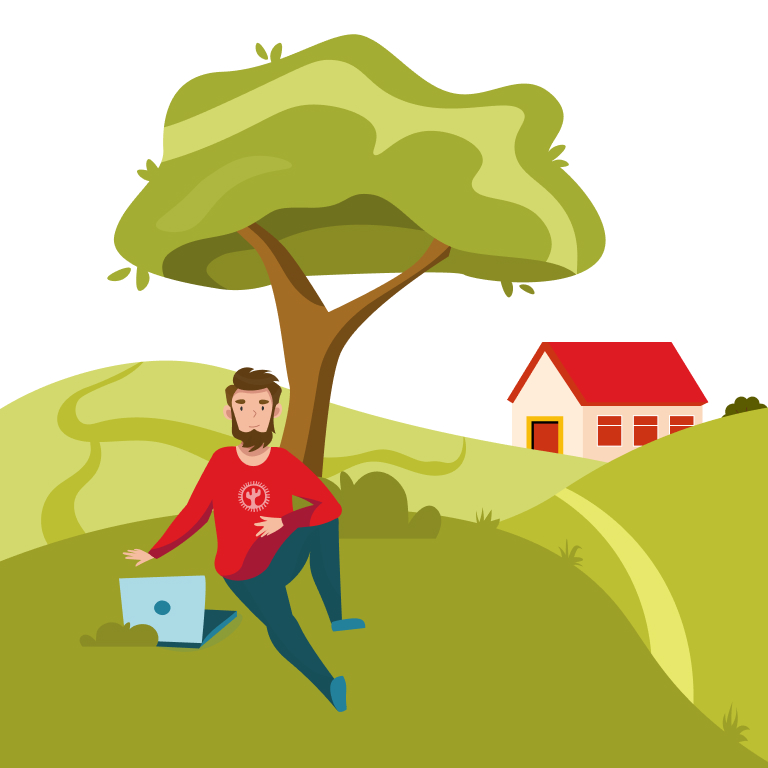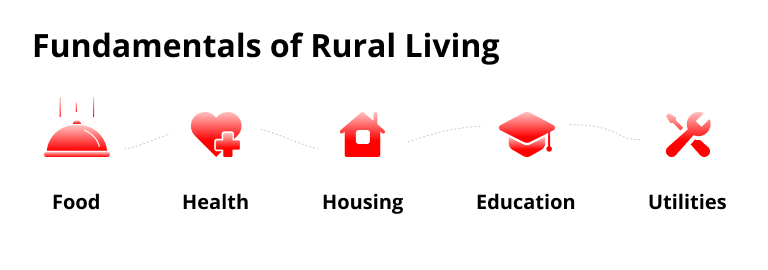Since the ’50s, we have seen a strong trend toward urban living. This trend has been driven by the lack of opportunities in rural areas as local manufacturing lost its battle against globalization. Hence, people moved where the opportunities arose: in the ever-bigger cities. Rural life got somehow lost as schools, followed by shops, closed down and ever more people left the rural areas for the cities. Spain claims to have about 3,900 abandoned villages and about a decline of 4mln people in the last 50 years.

Despite this clear trend, disappointment was the main sentiment for the migrants: it was hard to build new social networks and get used to smaller living, but above all some cities faced a lot of poverty because the jobs did not cover the bills. Life in the city proved to be hard and even created tension – think about “les gillets jaunes” in France, where the problem of not having a decent quality life while working full time shows something got fundamentally wrong…
Fifty years seems to be a long time, but it isn’t. When you talk to Spanish or Italian citizens living in large cities, they still typically talk full of passion and adoration about ‘their village’. The village of their parents or even grandparents is usually where they spend vacations. Relentlessly they mention how beautiful it is, how great the food is, and how wonderful life used to be.
For a number of years, numerous initiatives have been taken to incentivize the back-to-nature movement. A group of 100 academic people has looked at initiatives to bring people back to rural areas. Facebook groups such as pueblos abandonados de españa or examples on websites like EspanaFascinante show initiatives happen often but seem to lack scale and success.
But, the feelings got only stronger during the lockdown following the COVID-19 pandemic in 2020-2021. People got literally stuck in their too-small city apartments. What a lot of people thought for a long time was unlocked by the pandemic. It looks like the time is ready to see a new exodus, back to the roots, back to nature, back to rural areas.

Why Will The Revival of Rural Living Really Accelerate Now?
Technology, along with the negative lockdown experience and the big gap in house prices have fueled the mindset of many. 2021 will be the year of the revival of rural areas! Technology will be the big game-changer plugging the gaps in current rural living. Furthermore, there is a window of opportunity generated by the coronavirus that will accelerate the movement. The following trends will prove to be the enablers:
- Broadband internet available everywhere. Satellites are in place to allow for broadband internet in virtually every corner of the globe.
- EdTech has gained maturity during the corona crisis, and institutions now realize that education from a distance has become mainstream. When you can’t go to the classroom, the classroom will come to you.
- MedTech has also gained momentum due to the coronavirus and large investments in disrupting technologies. Think about proactive detection of medical problems through wearables, video consultations, and more.
- Remote working. Platforms for remote working have proven their success. Workers love not having to commute. Over 25% of all jobs now classify for 100% remote working. Visiting the office could happen by exception instead of by default. The coronavirus also caused companies to understand that remote working is not a bad thing but also an opportunity: office costs are reduced, commuting times are gone.
- Back to nature. During the lockdown periods people have walked in nature and felt connected again. Pollution in the big cities seriously damages the quality of life.
So, what if we could push the opportunity a bit? What if employers would enable rural living? Could we imagine making rural living ‘great again’? Yes, we can.

Setting the Basics Right
So here’s the plan. Let’s be the architects of up to 1 billion people moving back to rural areas, back to nature. Here’s what we lack to solve the question that would start convincing people around the globe.
First of all, let’s model the fundamentals: food, housing, health, utilities, and education.
Food
The main challenge is the physical aspect of food: it needs to be delivered somehow to the people. It can’t be virtual: food is a real ‘analog’ thing. That’s why smart logistics come into play. We need to set up the supply chain towards the villages. Given all the e-commerce shops and food delivery platforms that became mainstream during the corona crisis, the one thing that is missing is a platform that connects webshops to deliver to a central place in a large city from where distribution to the rural area happens for those products that don’t exist in the rural world. Eggs should come from chicken around the corner, undoubtedly. So, some logic is needed to check the local supply before granting it to a global supplier. Later on, truck delivery will be replaced by drone delivery. And of course, ultimately, restaurants and local shops will arise in villages as the population grows.
Housing
Today, village houses are numerous and cheap. Entire Italian villages are for sale for 1 euro. Buying such a house comes unfortunately at a practical inconvenience, as it often needs restoration. But, given the gap in acquisition cost compared to urban living, there is room enough to find solutions. The villages need to be eco from the start, by default. This is to avoid the trap of copying the problems of urban living: pollution needs to remain distant. Luckily, natural sources can supply energy and fuel electrical cars and bikes. Also, the shared economy could be implemented by default to ensure neighbors share assets leading to a lower total cost of living (TCL).
Health
Of course, special treatments need to happen in hospitals, but simple consultations and follow-up with citizens can happen through capturing data from wearables. A lot of health tech companies can now predict your health issues. Some pollution-driven diseases should decrease substantially in frequency due to better air quality. Alongside with that, basic consultations can happen over video calls and the presence of a real doctor can be arranged on a timely basis.
Education
Schools will not work in the ‘ramp-up’ phase where only a few pupils live in a village. You need some size to organize schools efficiently, but remote schooling can bridge the gap. We expect the schools to come to you, by opening access to programs from wherever you are with physical education by exception, for example for 1 week 6 times per year. Again, once there is a certain volume of let’s say 10,000 people in the area, a much higher rate of physical lessons can be set up. Professional education, however, can in many cases remain virtual by default.
Utilities
Broadband internet is a key enabler and needs to be set up at a reasonable cost, and be accessible for all. Water and energy supplies should be derived from the natural sources in the area, mainly sun and wind. Old-fashioned oil-driven energy supplies need to be limited to the bare minimum.

Awaken the Entrepreneur in You
So, dear reader, what’s next? Do you feel triggered? Awaken the entrepreneur in you!
Think about building a new ecosystem that brings it all together. It needs to be the glue that links citizens with suppliers of services and goods. We believe there will be a winning app that will be made in 2021.
As this is a global problem potentially affecting 1 billion people around the globe, the pie is rather large.
